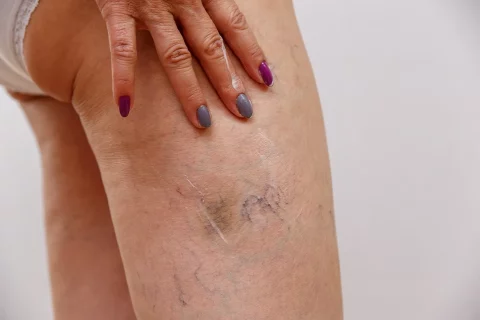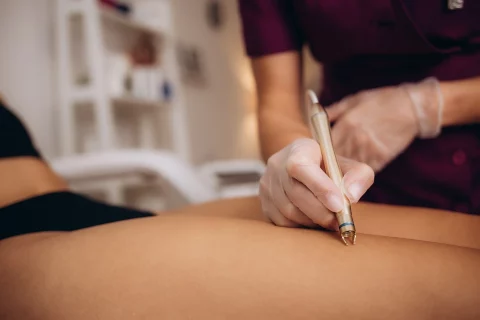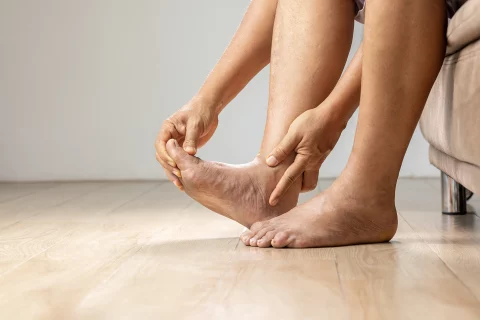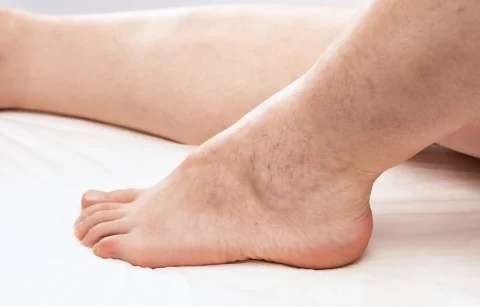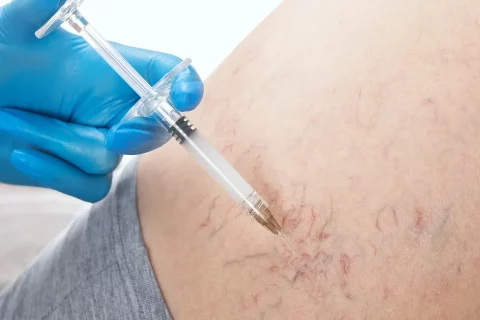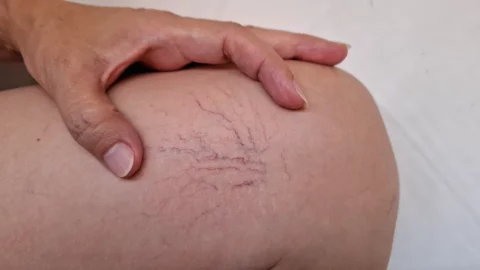Have you noticed lumps or knots developing at the injection sites after undergoing spider vein treatments like sclerotherapy? You’re not alone.
These knots are a common occurrence during the healing process, caused by a combination of trapped blood and the body’s natural response to the procedure.
Why Knots Form at Injection Sites After Spider Vein Treatments
When a sclerosing agent is injected into spider veins during sclerotherapy, the vein walls swell and stick together, stopping blood flow through those veins.
However, some blood can get trapped within portions of the closed veins, leading to the formation of tender lumps known as “trapping.”
You can think of these knots like traffic jams in your veins. As the sclerosing agent causes the vein “roads” to narrow and close, some of the “blood cars” get stuck within portions of the newly formed “tunnels.”
This trapped blood causes inflammation and swelling, resulting in the lumps and knots you feel under the skin.
Trapped blood is far and away the main culprit behind these injection site knots. But leakage of blood during the procedure itself can also contribute, as blood that escapes into surrounding tissues tends to pool and clump.
So in short, these knots are your veins’ and body’s natural response to the sclerotherapy process – not a complication in itself. The trapped blood needs time to either gradually reabsorb or be drained to resolve the lumps.
Staying patient during the healing process and following your healthcare provider’s aftercare instructions are key steps to promoting the knots’ disappearance over time.
Knots forming at injection sites after spider vein treatments are uncomfortable but common. Understanding the reasons behind them – trapped blood and the body’s natural response – helps you effectively manage and resolve them with the proper care.
Treating and Preventing Injection Site Knots
While injection site knots may clear up on their own over weeks to months, there are steps you can take to speed up the process and prevent recurrences:
Wear compression stockings
Medical grade compression stockings help maintain pressure on treated veins, reducing blood pooling that leads to trapping. Wear the stockings continuously for 14 to 21 days after sclerotherapy.
See your healthcare provider
They may aspirate or drain the trapped blood, immediately resolving the knots and bumpiness. Draining the trapped blood early on can help prevent staining of the overlying skin.
Apply gentle heat
Warm compresses applied 2-3 times daily for 15-20 minutes can help promote the absorption of trapped blood. Avoid heat immediately after the procedure.
Avoid heavy lifting and high impact activities
Straining your treated leg right after sclerotherapy can push more blood into trapping and worsen knots. Take it easy for at least a week.
Engage in light exercise
Gentle movement like walking boosts blood flow and tissue healing. Aim for 30 minutes of light exercise daily once the acute recovery phase passes.
Use topical treatments
Arnica gel or creams applied to injection site knots may speed up their resolution and reduce bruising that can occur.
Stay hydrated
Drinking plenty of water helps your lymphatic system eliminate trapped blood and other waste, potentially reducing the appearance of knots more rapidly. Aim for around 2-3 liters of water per day.
While injection site knots often resolve on their own over time with proper care, consulting your healthcare provider early on is key to expediting the process and preventing future trapping. They can evaluate your treatment, make minor adjustments to technique, and create a customized care plan to achieve optimal results.
When to Seek Medical Attention for Injection Site Knots

In most cases, knots at injection sites after spider vein treatments resolve on their own within a few weeks with proper care and compression.
However, there are situations where seeking medical attention sooner is advised:
Significant pain. If the lumps are extremely tender and painful beyond mild discomfort, see your doctor as soon as possible.
Redness and warmth. Redness and heat radiating from the knots may indicate infection, which requires prompt treatment. Schedule an appointment within a day or two.
Spreading. If the lumps begin to grow in size or spread to other areas of the leg, see a healthcare provider to rule out complications.
No improvement. If the knots show no signs of shrinking after 2-3 weeks of proper care, see your doctor to determine if trapped blood needs to be drained or the procedure needs to be repeated.
New symptoms. Developing symptoms like fever, chills, or worsening leg pain beyond initial tenderness could indicate a serious problem. Seek immediate medical attention.
Allergic reactions. If you experience hives, swelling, or other allergic reaction symptoms at the injection sites, seek medical attention to identify the cause and properly treat the reaction.
Concerns. Even if none of these scenarios apply, always consult your healthcare provider if you have concerns about lumps at injection sites or your recovery in general after spider vein treatments. They can evaluate your situation and determine appropriate next steps to ensure optimal results.
While knots at injection sites after spider vein treatment are a normal reaction, certain warning signs indicate the need for faster medical evaluation and intervention.
Consulting your healthcare provider to rule out potential complications and appropriately treat stubborn knots is always recommended.
When Will Injection Site Knots Disappear?
Many factors influence how long knots at injection sites after spider vein procedures will persist:
Size and number of trapped blood pockets: Larger trapped blood pockets resulting from treating multiple veins tend to take longer to resolve than smaller ones.
Severity of trapping: More severe trapping with extensive lumps and bumps may require longer to reabsorb spontaneously or after drainage by a healthcare professional.
Application of compression: Properly applying compression stockings as directed helps prevent additional trapping and speeds up the absorption of existing knots.
Repeat procedures: Veins that require multiple sclerotherapy treatments are more prone to recurrent trapping that takes longer to fade.
Response to treatment: How well your body responds to measures like compression stockings, heat therapy, and drained trapped blood pockets impacts resolution time.
As a general guideline:
- Mild trapping: Small bumps from minimal trapped blood often resolve within 1-3 weeks with proper compression and care.
- Moderate trapping: Trapped blood pockets causing noticeable but not large lumps typically take 2-6 weeks to fully reabsorb or fade after drainage.
- Severe trapping: Large, uncomfortable knots from extensive trapped blood can persist for 4-12 weeks, even after aspiration.
- Recalcitrant trapping: In rare cases where measures fail to alleviate lumps, trapped blood may take 3-6 months or longer to fully resolve on its own.
While researchers have not identified an average time for injection site knots to disappear after spider vein procedures, most cases clear up within 6-12 weeks with appropriate care and treatment.
But many factors influence the specific duration in each individual case. Consulting your healthcare provider for guidance and tailored recommendations can optimize how quickly your knots resolve.
In summary, a wide range of timeframes exists for when knots at injection sites after spider vein treatments might disappear.
More severe cases, ineffective care measures, and the need for repeat procedures can prolong the persistence of lumps.
Proactively working with a healthcare professional and seeking treatment when needed helps ensure trapped blood pockets resolve as quickly as possible.
FAQs About Injection Site Knots and Spider Vein Treatments
Can spider vein treatments cause varicose veins?
No, properly performed spider vein treatments target superficial veins near the surface of the skin and are designed not to impact deeper vein structures. Varicose veins result from issues within the deeper venous system.
What conditions rule me out of spider vein treatments?
Certain medical conditions like deep vein thrombosis, recent blood clots, and superficial thrombophlebitis can make spider vein treatments unsafe. Discuss any relevant conditions with your healthcare provider to determine if treatments are suitable for you.
Can sclerotherapy treat varicose veins?
While sclerotherapy can treat some smaller varicose veins, it is primarily effective for abnormal superficial veins near the skin’s surface. Larger varicose veins involving the deeper saphenous vein often require separate interventions.
Can knots form in deeper veins?
Most injection site knots result from blood trapping within superficial veins close to the skin. Deeper vein structures have thicker walls that are less prone to trapping, though a small amount of deeper vein thrombosis can occasionally occur.
What vein structures are typically treated?
Spider vein treatments target the superficial venous system – smaller, abnormal blood vessels near the skin’s surface. This includes reticular veins just under the skin as well as the smaller branches of the superficial venous system.
When to Expect Knots After Spider Vein Treatments

In general, you can expect knots to appear at injection sites within a few days to 2 weeks after spider vein treatments:
Immediately after treatment: Some patients experience bruising, swelling, and very mild lumps immediately or within a day or two of procedures like sclerotherapy. This is due to blood leakage at injection sites during the procedure itself.
Within a week: Most patients develop noticeable knots from trapped blood within 1 week of treatment as the treated veins swell shut. The lumps tend to peak in size and discomfort around this time.
1-2 weeks post-procedure: While knots often form within days of spider vein procedures, they may continue to develop and become more prominent for up to 2 weeks as the body’s inflammatory response peaks.
The timing of knot appearance varies for a few key reasons:
Technique: Healthcare providers who take steps to minimize blood leakage during procedures tend to see fewer immediate knots.
Spider veins treated: Treating more substantial veins and larger treatment areas correlates with earlier knot formation.
Individual response: Each patient’s body responds slightly differently to sclerotherapy and other procedures. Some experience more inflammation and trapped blood than others.
Additional factors: Medications, allergies, and underlying health conditions can impact how quickly a patient develops knots after treatment.
In summary, while injection site knots after spider vein treatments most commonly appear within days to weeks of the procedure, the precise timing varies significantly from person to person.
Factors like the extent of the treated area, the healthcare provider’s technique, and an individual’s response influence when and how prominently knots develop.
As long as knots do eventually appear and resolve within an appropriate time frame—generally 4 to 12 weeks—the timing of their initial formation is not typically cause for concern.
However, consulting your healthcare provider about any questions regarding knot development after your spider vein procedure is always recommended.


